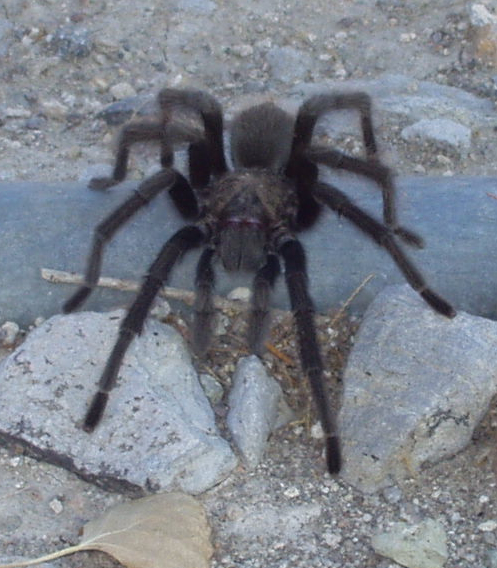Talkin’ ‘Bout Mygale . . .
Tarantulas were my first love. Not the exotic pet sort of tarantula, but the rangy, shaggy, Tootsie-roll-colored spiders that roam the California hill country every fall. (Mygale is French for tarantula, which I need to mention so as to make sense of that headline.)

First name, Aphonopelma. Last name . . . not sure of species. But you can call me Mr. T. (Photo by Toiyabe–Creative Commons)
Incredible. You spend your whole life somewhere and don’t even notice an animal that lives right next door—though to be fair, they do lie low. Most people know that male spiders of all kinds saddle up and begin to wander as the year winds down, because that’s when everybody is sexually mature and preparing for the next generation. But house spiders are one thing; you can shrug at a wolf spider hustling across your rug. A slow-motion marathon of big, lovelorn tarantulas ambling across the trail is another thing entirely. Yet I had never noticed them.
One year I was living not far from the golden slopes of Mount Diablo in Contra Costa County. A story in the paper mentioned the striding tarantulas, which emerge from the ground in September and October to prowl the hills. Dry weather after the first autumn rain is said to encourage them. So I took my bike up the mountain (riding uphill . . . uphill! I used to do that) and bumped into a number of tarantula guys on walkabout.
What a sight! They’re leggy spiders, these Californians. The males are lean and look almost all leg; the females are chunkier, like the classic pet-store tarantula, but you won’t get to meet them because they’re waiting in their burrows for gentleman callers. I followed a few of the males and took note of the delicate sounds they made when walking across the leaf litter; it’s quiet on the mountain. I worked up my courage and put a flat hand in front of one of them; he crossed it without breaking stride. I didn’t bother them otherwise, knowing they were on their first and last mission.
The tarantulas on this mountain (Aphonopelma smithi) are known as Bay Area blonds, though to be honest they look more like dirty blonds (makes sense, I guess, for a guy who lives in a hole. And a Californian at that). And what looks like aimless wandering is just the prelude: male tarantulas sniff for a chemical signal, left on silk, that indicates a female’s burrow is nearby. Then they follow their chemoreceptors, as guys will do. Perhaps some of the males I saw that day got lucky; I’ll never know.
A lovesick tarantula is one of the better ways to engender sympathy among otherwise spider-fearing humans. You empathize with him . . . It’s hot, he’s lonely and lost, he’ll never see home again, but if he can find the one, his genes will outlive him and the spider walk will continue. After I let that tarantula cross my hand, I understood. He was supremely indifferent to me and all human schemes. He had his one priority, which was not biting people and was not terrifying bloggers. He just had to live long enough for his life to have meant something.
I had nothing to fear. But he did.
It’s tarantula season again, and if you can bear the suspense a fine way to celebrate the spiders comes October 4, when Henry W. Coe State Park holds its annual Tarantula Fest and BBQ. Tarantulas will not be barbecued—only steak, chicken, hot dogs, and vegetarian burgers. Last year at the fest the dirty blond spiders were not in abundance, and I wonder if the continuing ultra-drought will affect them this year too. But there are other spiders, music, and wonderful views. You can get a T-shirt stenciled with spiders and watch kids be brave. Unlimited refills on the spider solidarity.